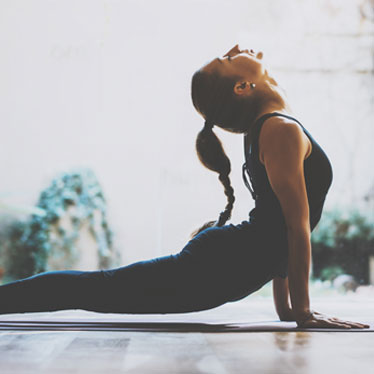Yoga For Cellists

Did you know dedicated musicians are as prone to injury as their athletic counterparts? Scientific research shows taking precautions via proper postural technique and proactive physical conditioning, goes a long way in preventing the overuse injuries prevalent in string musicians.
In addition to the current tenets you're learning about healthy playing posture and fingering/bowing techniques, integrating yoga into practice warm-ups can have both real-time and long-term health benefits for cellists.
Yoga helps prevent injuries from strain and overuse
Each instrument has its share of potential discomforts and injuries. For cellists, those include:
- Hand strain and tendonitis in the left hand.
- Wrist, forearm, and shoulder ailments in the bowing arm (usually the right arm unless you're left-handed).
- Shoulder, neck, and upper-back pain as the result of continuously curved body posture.
Those are the injuries caused by playing the cello; cellists and bass players are also more prone to back and other physical injuries as the result of carrying their large, heavy instruments. Yoga incorporates a range of practices into one exercise form, including strength training, endurance building, stretches to improve flexibility and the breathing and inherent focus on mindfulness. It provides lifelong benefits that go beyond the instrument and the stage.
If you're particularly interested in strength-training, we recommend reading, Strength Exercises for Cellists and Bassists.
All of the yoga poses recommended for violinists are also good for cellists, bass players, and other string musicians. However, there are a few more postures that will help cellists open and expand their shoulders, chest, and back.
Bridge Pose
In addition to opening and stretching the shoulders and upper-back muscles, Bridge Pose builds strength in the upper-arms, shoulders, neck, and core. Over time, increased strength is an asset in maintaining proper playing posture and for your bowing arm.
Cat and Cow Pose
Cat Pose and Cow Pose are lifesavers for anyone who sits in cramped or unnatural positions for any length of time. Done in alternating sequences, they help the spine and its surrounding muscles to run the gamut from expansion to contraction, and back again, realigning anything that has been tensely held out of alignment, boosting circulation and relieving tension.
Yoga Poses for Wrists & Arms
The demands placed on a cellists' fingers, wrists, and arms are notable, particularly when you consider how repetitive those actions are over the course of a year, a decade, and a lifetime. String musicians are at risk for developing carpal tunnel, tendonitis and other musculoskeletal conditions affecting the connective tissue of the hands and arms. To keep in shape, develop dexterity, and give overworked muscles a break from the norm, try these yoga stretches and poses designed to address wrist pain and prevent (or treat) carpal tunnel syndrome.
Breathing, relaxation and stress-release prevent anxiety and burn-out
There's no mystery around why music students are prone to higher stress levels than students who don't participate in music and other extracurricular activities. In addition to busy school and work schedules, becoming a proficient musician requires countless practice hours at home, above and beyond lessons and/or orchestra rehearsals. Thus, many university music programs, including prestigious programs such as Julliard, incorporate stress management into their curriculum.
Then, when you throw in demanding performance schedules, and the perfectionism that often goes along with intermediate and advanced musicianship, musicians can find it beneficial to stop, breathe, and come back to the present moment. That's where yoga comes into the mix.
Systematic reviews of yoga studies demonstrate yoga is an effective stress management tool, and it can also be used to quell anxiety - two emotions that plague musicians. In Yoga Journal, renowned yoga instructor and author, Baster Bell, wrote about the benefits of yoga for musicians. In addition to addressing postural and stamina issues that plague string musicians - especially those who practice hours per day - yoga also improves mental focus and creativity.
Bell writes, "...the mental benefits of yoga asana (poses), pranayama (controlled breathing), and meditation could lead to improvements in performance for both aspiring and established musicians. Yoga meditation practices seem to support the creative process, and also help to improve mental focus, which should help out those classically trained players trying to memorize pages of Chopin or Bach."
Musicians are busy and getting to the gym or an exercise class isn't always easy. Yoga, however, can be practiced in the most confined of spaces; all you need is a room to stretch out. Sitting quietly, breathing, stretching and holding poses can happen in a practice room, an empty hallway or in the corner of your school's rehearsal space during breaks. This video featuring cellist Sturman provides simple yoga stretches that can be done next to your rehearsal chair and while seated.
Give yourself four to six-weeks of consistent yoga practice and we’re confident it will enhance your cello playing – and your life.


